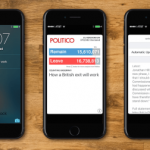Users 46 To 60 View Mobile As Essential Tool
Users 46 To 60 View Mobile As Essential Tool
by Laurie Sullivan @lauriesullivan, April 11, 2017
Nearly one-third of consumers between 46 and 60 made purchases via their mobile devices, while 34% have downloaded the app from their bank, and 30% have read email marketing messages, according to a recent study.

Consumers of all ages are doing more than simply searching for information online from their mobile phone.
The Relevancy Group study — “The Consumer Companion: The Implications of Mobile Usage and Smartphone Ubiquity” — conducted in October 2016 among 1,000 participants and released Monday found that even 26% of those ages 46 to 60 have watched video on their phone.
Most marketers know that mobile campaigns speak to Millennials, but findings from the study show that for consumers ages 46 to 60, there is a “surprising willingness” to interact with brands on mobile, said Joe Laszlo, principal analyst and research director at The Relevancy Group and former Interactive Advertising Bureau VP.
While this demographic may show a “willingness,” interactions peak for consumers ages 33 to 45, Laszlo said.
Consumers are willing to interact with brands on their mobile devices, but the mobile experience must present a fun or rewarding experience. “I don’t think we are anywhere near an ‘ultimate’ mobile experience, but I’m encouraged by the fact that there are more and more mobile content and marketing experiences that don’t look like they were simply ported over from the PC or TV or some other medium,” Laszio said.
For example, companies using Snapchat as a publishing platform are learning to tell stories in an animated, engaging and funny way completely made for mobile. Laszlo said those design principles are starting to proliferate across sites and apps, improving the look and usability of the mobile world.
Mobile continues to be seamlessly integrated into people’s daily activities, “almost becoming an involuntary activity like breathing,” Laszio said. He thinks that within two to five years, advertisers and consumers will stop consciously thinking about mobile data and instead when they say “internet,” “interactivity” or “digital” they will mean smartphone-based services.
“PC-based connectivity will be the special case — something the average consumer reaches only for particular tasks, if at all,” he said. But Laszlo’s report shows the ad industry has a way to go before that happens. Today, many marketers at retailers and brands still struggle with getting consumers to download and use their apps.
Apps have become an opportunity and a challenge mainly because each requires a customer to download the app and continually demonstrate brand loyalty by using it. Some 28% of consumers participating in the study say they will download a retailer’s or a brand’s app, yet at the highest number only 37% will use between 6 and 10 of the apps downloaded on the devices.
Women are slightly more likely than men to interact with brands on their phones. About 30% of men say they never interact with brands, compared with 25% of women.
In fact, there are several specific brand-related activities women are significantly more likely to engage in. Some 48% of women versus 38% of men say they will visit a retailer’s or brand’s Web site on a mobile device. About 31% of women said they will download a retailer or brand app vs. 26% of men. Clicking on email marketing messages is another, 25% vs. 20%, as well as opting into text messages at 26% vs. 167%, respectively.
eMarketer released new data Tuesday that shows Americans now spend more time with mobile apps and less time in mobile browsers, yet the number of apps are slightly declining. Most of its down listening to digital audio, social networking, gaming, viewing videos and messaging.
MediaPost.com: Search Marketing Daily
(18)







